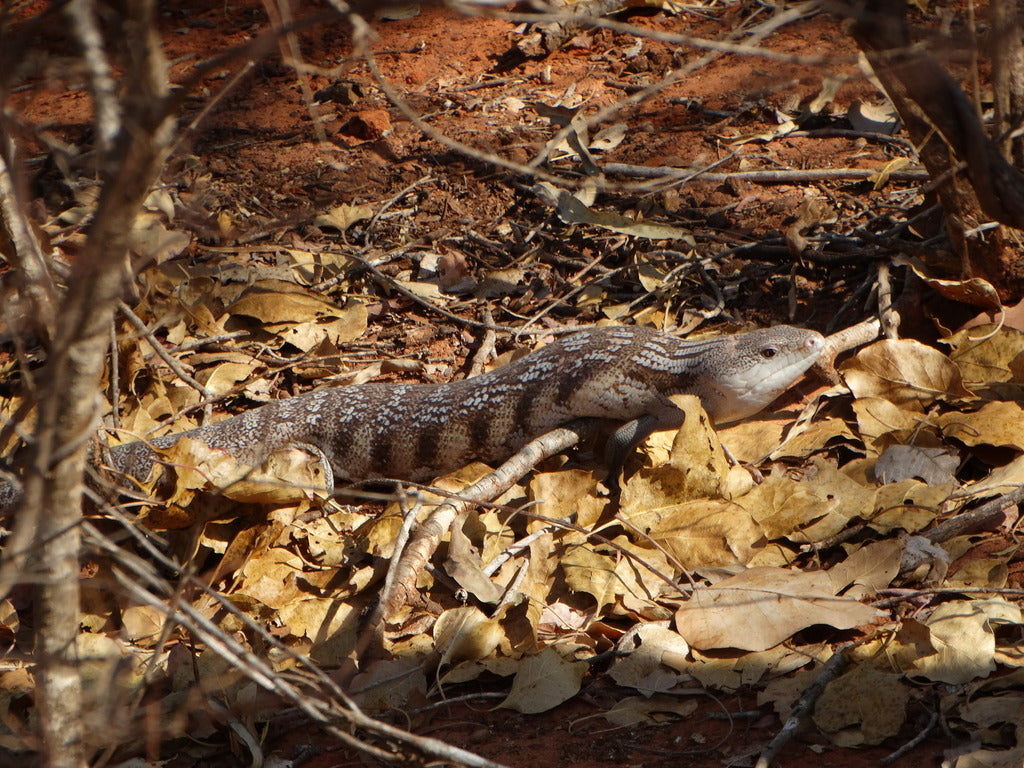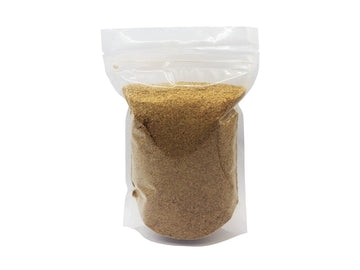If you’re planning on getting a pet Northern blue tongue skink, then the first thing you need to do is set up an appropriate terrarium for it to live in. Blue tongue skinks aren’t like other types of pets that you may be more familiar with, such as dogs or cats. They can’t simply live free-range with you in your home; instead, they need a terrarium that has the right equipment in the right arrangement to create a usable environment that replicates the conditions of their native habitat.
If you haven’t read our Blue Tongue Skink Care Sheet yet, read that first! Once you have a basic understanding of what your new pet needs from its habitat, you’re ready to start setting up a Northern blue tongue skink terrarium.
It may seem expensive to buy all of these supplies for “just a lizard,” but they are essential to your pet’s survival. Without an appropriate terrarium to live in, your new pet is likely to get sick and die. Here’s our step-by-step guide to successfully setting up a Northern blue tongue skink terrarium so you and your beloved pet can enjoy many years together!
Step 1: Choose the Right Terrarium
Northern blue tongue skinks are terrestrial and generally grow up to 24” long, and need a terrarium that is appropriate for that size of lizard. 4’L x 2’W x 2’H is the minimum acceptable size for housing this species, although larger is better.
This terrarium can be made from wood, PVC, or even glass, but it should be front-opening and have plenty of ventilation for healthy airflow, whether in the form of a mesh top or side vents. We prefer enclosures with a mesh top design, as they make it much easier to safely install heat, UVB, and 6500K lamps.
If your terrarium doesn’t have opaque sides, you will need to cover them with something to help your blue tongue skink be comfortable in its environment. This can be as simple as construction paper or as elaborate as a 3D textured background.
Products we recommend:
Step 2: Arrange Your Lighting and Heating Equipment

To heat and light your Northern blue tongue skink’s terrarium appropriately, you will need the following equipment:
- Heat lamps (at least 2)
- UVB lamp
- 6500K grow lamp
Both heat lamps should be placed on the right or left side of the terrarium, close together. The UVB lamp should be placed on the same side so it fully overlaps with the beams from the heat lamps. The 6500K lamp should be placed on the same side as the others, extending along most of the length of the terrarium.
Products we recommend:
- Fluker's Mini Sun Dome Lamp, 5.5"
- Zoo Med Repti Tuff Splashproof Halogen Lamp, 90w
- Arcadia T5 HO Dragon 14% UVB bulb, 22”
- Arcadia ProT5 Lamp Fixture, 24”
- Arcadia Jungle Dawn LED
Step 3: Start Minimalist
With any new pet reptile, it is best practice to quarantine them for 3-6 months after bringing them home, especially if you have other pet reptiles. When you first set up your Northern blue tongue skink terrarium, it’s best to start simple so you can quarantine them efficiently.
Here’s what you need at minimum:
- paper towels
- flagstone
- hide box or cave (x2)
- water dish
- artificial foliage
- digital thermometer/hygrometer device (x2)
The flagstone should go directly under the heat lamps in order to absorb heat and create an ideal basking site. Place the thermometer probes so one is on the basking surface and one is on the cool side of the terrarium. Your temperature gradient should look like this:
- Basking temperature — 95-105°F
- General air temperature — 70-85°F
- Nighttime — 65-75°F
If temperatures are too high, use a plug-in lamp dimmer, thermostat, or a lower bulb wattage. If the temperatures are too low, you will need higher-wattage bulbs.
Make sure none of the décor allows your skink to get closer than 13” directly under the UVB lamp, as UVB intensity increases with proximity to the bulb.
Products we recommend:
- Exo Terra Reptile Cave, Large
- Zoo Med Repti Ramp Bowl, Large
- Exo Terra Boxwood Bush
- Zoo Med Digital Combo Thermometer Humidity Gauge
- Zoo Med ReptiTemp Rheostat
Step 4: Quarantine for at Least 3 Months
The purpose of using a minimalist setup for quarantine is to make it easy to keep clean. During this time, monitor your blue tongue skink for signs of illness. Get it tested by an experienced reptile veterinarian for intestinal parasites, and administer treatment if needed.
The paper towels should be changed out daily, and the enclosure and all accessories should be disinfected at least 1x/month. Use a bleach solution (¾ cup bleach per gallon of water) or veterinary-grade disinfectants like F10SC and Clean Break.
Step 5: Add Substrate
Once quarantine is over, you can work on giving your Northern blue tongue skink terrarium a fully-enriched, long-term layout. It won’t need to be cleaned quite as often — only once every 3-6 months, depending on how good you are about spot-cleaning.
The first step of setting up a long-term terrarium design is adding a naturalistic substrate. For a Northern blue tongue skink, it’s best to use fine sand or sandy soil. You will need at least 4” of substrate to provide a burrowing medium, so for a 4’x2’ terrarium, count on at least 80 quarts or 2.7 cubic feet of substrate.
If your terrarium has different dimensions, you can estimate the amount of substrate you’ll need by multiplying the length x width to get the number of cubic inches of substrate it will take for 1” deep of substrate. Then multiply that number by the desired depth of substrate, then convert the resulting number to quarts or cubic feet.
Step 6: Add Environmental Enrichment
Environmental enrichment is the process of strategically adding items to your blue tongue skink’s terrarium that make it more functional for the occupant. Now it’s time to get creative! The best way to get inspiration for your terrarium’s appearance is by looking at pictures of Northern blue tongue skink habitat on sites like iNaturalist and Flickr.
Place the water bowl, hide, and basking platform first, and build around those. Make sure the water bowl is accessible and easy to remove, and leave enough open space for the skink to easily get around.
Rocks
Stacked flagstone can make an attractive and very functional basking platform. However, make sure to glue them together with cement or silicone so they can’t collapse on top of your dragon.
Ledges
Magnetic ledges increase the available surface area in your enclosure, look great, and encourage climbing. Hammocks also offer a similar function. However, keep in mind that because they don’t absorb heat, hammocks should not be used as basking platforms.
You don’t have to worry too much about mold in the semi-arid environment of a Northern blue tongue skink terrarium, so you can use essentially any wood you want. Mopani wood, cork bark, grape vine, cholla wood, and manzanita wood can all work. However, whichever you choose, make sure the wood is broad enough to support your skink’s entire body and doesn’t go too high off of the ground in case your pet falls.
Whether real or fake, plants are a great way to make a reptile terrarium more attractive. However, keep in mind that because blue tongue skinks are omnivorous, they may try to eat any plants or plant-like objects you put in the enclosure.
Live plants should be kept in pots to help keep the water close to the roots, unless the enclosure is bioactive (which this article is not covering). Use drought-tolerant plants tolerant of higher ambient temperatures and moderate to high amounts of light. Some suitable options include:
- Air plant (Tillandsia)
- Agave
- Aloe
- Carex grass
- Elephant bush
- Festuca grass
- Gasteria
- Haworthia
- Hens and chicks (Echeveria)
- Ice Plant
- Jade plant (Crassula ovata)
- Prickly pear cactus (Opuntia danicolor) (spineless)
- Sempervivum
For more safe plant ideas, visit The Tortoise Table.
Conclusion
Even after you’ve set up your blue tongue skink’s long-term terrarium arrangement, it’s okay to rearrange it every so often as you come to understand Northern blue tongue skink husbandry better. It also helps keep your pet’s environment “fresh” and stimulates them to explore and exercise!
"Photo 127373902" by Andrejs Medenis is licensed under CC BY-NC 4.0











